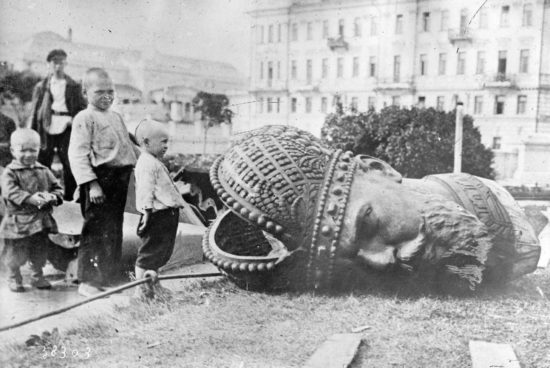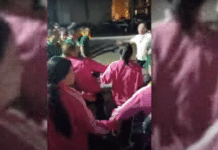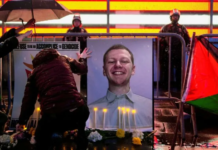Lessons for today’s struggles against dictatorship
Vincent Kolo, chinaworker.info
In the February Revolution of 1917, (March in today’s calendar) the centuries-old system of Russian tsarism came crashing down. It was the working class especially of the capital Petrograd that made this revolution, spurred into action by the heroic women workers. The emblem of the February Revolution was the red flag of the international working class, outlawed under the tsar, but suddenly seen everywhere across the Russian capital.
This fact alone correctly identifies which political force carried through the revolution against the tsar: It was not the liberals or foreign ‘democracies’ but the socialist-influenced working class of Russia, pulling behind them other oppressed layers. But this is something the representatives of bourgeois liberalism – then and now – have worked assiduously to obscure, falsely trying to grab the credit for establishing democracy in Russia as part of their campaign to denigrate the October Revolution, which overthrew capitalism and brought the working class to power.
While in reality the Russian capitalists, and this includes the liberal Kadet party, did their utmost to prevent the February Revolution and rescue the tsar’s decaying regime; they found themselves thrust into power by events beyond their control. A capitalist Provisional Government was formed with an extremely shaky basis of support. Understanding the reasons for this paradoxical outcome in February is important for understanding the Russian Revolution as a whole, and other revolutionary movements during the century that has followed.
Having defeated one of the most brutal regimes ever seen, the working class was not yet fully conscious of its power – a phenomenon we have also witnessed in other revolutions. In the furnace of revolutionary events during 1917, with each calendar month bringing new crises and upheavals, the workers, soldiers and poor peasants of Russia would prove to be fast learners.
This successful outcome hinged upon one crucial factor: the existence of a mass Marxist party, the Bolsheviks (later to become the Communist Party), led by Lenin and Trotsky. This made possible a rapid political realignment within the working class, draining all support for the capitalist government and rallying around the programme of the Bolsheviks, for the working class to take power with the support of the rural masses and other oppressed layers. This prepared the ground for the October Revolution, which completed the ‘unfinished business’ of February, and established the first democratic workers’ government in history. As the leaders of the revolution stressed, this marked the beginning of the worldwide socialist revolution and was met with mass enthusiasm by workers and oppressed peoples around the globe.
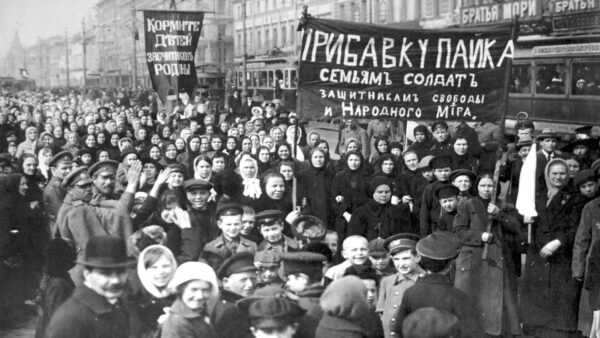
Women show the way
The women workers of Petrograd provided the first spark for revolution in February. Since 1911, International Women’s Day (23 February by the old Russian calendar, but 8 March nowadays) had become established within the Russian working class as a day of rallies and protests. Amid severe inflation and widespread food shortages in 1917, aggravated by the war and hoarding by speculators, that year’s commemorations had an explosive edge. These conditions recall more recent revolutionary upheavals in Tunisia and Egypt, which at first were dismissed by capitalist commentators as ‘bread riots’.
Women made up one-third of the workforce in Petrograd and their role in the economy had increased significantly during the war. Since the revolution of 1905 there had been a marked politicisation of women workers and a number of important strikes in industries such as tobacco and textiles where large numbers of women were employed. The Bolshevik Party put considerable attention into organising among women workers and launched a women’s newspaper in 1913 (before its press was banned under wartime censorship laws).
A secret police agent filed a remarkably accurate report in February: “These mothers, exhausted from standing endlessly in lines and having suffered so much in watching their half-starving and sick children, are perhaps much closer to a revolution than Messrs. Miliukov, Rodichev, and Co. [leaders of the Kadets], and of course they are much more dangerous.” [The Fall of the Romanovs, Mark Steinberg and Vladimir Khrustalev]
In a movement from below, which as Trotsky pointed out took even Bolshevik activists by surprise, several thousands of women textile workers went out on strike on 23 February and called out their male comrades. “Down with the war: Down with high prices! Down with hunger! Bread for the workers!” – these were the slogans as recalled by a Bolshevik worker who heard the women approaching his factory from the street below. By the end of the day, around 90,000 had joined the strike and the following day their number doubled.
“A hooligan movement”
Also, the political temper of the movement would harden, spurred by the conscious intervention of socialist activists, many in or around the Bolsheviks, with demands for bread being overshadowed by slogans against the tsar’s dictatorship and a conscious plan developing to spread the strike and fraternise with the soldiers. By the 25th, almost every factory in Petrograd was closed down, as were many shops and services. Students, white-collar workers and teachers joined the workers in the streets.
The following day the regime launched a crackdown with mass arrests of worker activists and orders for the army to fire on the demonstrators. “Its a hooligan movement,” wrote the tsarina Alexandra to her husband. “Young boys and girls running about and screaming that they have no bread… and then the workmen preventing others from working.” Clashes and shootings continued the following day, but tensions within the army, torn apart by the same pressures raging in society at large, exploded in mutiny. The first regiments revolted against their officers leading to a domino effect. By the night of the 27th the entire Petrograd garrison of 150,000 men, the only power that stood between the tsar and the revolution, had melted away. By the morning of the 28th it was clear that nothing could save the regime. The tsar abdicated on 1 March.
The radicalisation of the rank and file soldiers had been prepared by three years of horrific warfare. By the start of 1917, army desertions were running at the rate of 34,000 a month. With 3.8 million dead, Russia suffered the highest death toll of all the combatant countries. While the February Revolution was not bloodless, claiming 1,443 lives, this was a small number measured against the carnage of the war. (This death toll was far higher however than during the October Revolution, for which the working class was much better prepared).
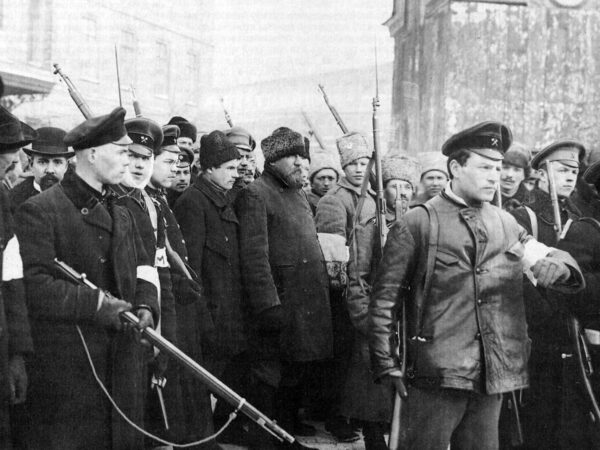
Tsarist rule
Tsarism ruled a huge empire with a vast bureaucracy and military apparatus. Nicholas II, the last tsar, was known as “Nicholas the Bloody” for the many massacres during his rule and especially the vicious repression used to restore his regime’s control after the 1905 revolution. This claimed the lives of 48,000 people between October 1905 and April 1906 alone, according to the German historian Manfred Hildermeier.
Appalling pogroms were unleashed upon the Jewish population – the tsar and his family were religious fanatics and ingrained anti-Semites. Nicholas II believed the 1905 revolution had been directed by, “the steering and destructive hand of Judaism”. He believed his grandfather, Alexander II, had been murdered by the same Jewish conspiracy. Winston Churchill later expounded similar ‘theories’ about the Jews being the cause of the Russian Revolution, as did Hitler and the Nazis. Indeed, the tsar’s racist militia, the Black Hundreds, was a prototype for the Nazis and other fascist parties.
There was a close bond between the tsar, who was its head, and the established Russian Orthodox Church, which stood for a deeply authoritarian ideology. There is a certain similarity with today’s Chinese state, with the so-called ‘Communist’ party standing for a revamped Confucian ideology consisting of right wing nationalism, conservative values and authoritarianism.
The Orthodox Christian hierarchy denounced ‘Western parliamentarism’ as unsuitable for Russia and claimed that only the tsar’s dictatorship could save Russia from revolution and ruin. This was the congenital outlook of the ruling group. The tsarina famously claimed, “Russia loves to feel [the] whip – it’s their nature – tender love and then the iron hand to punish and guide.” She held the Black Hundreds thugs to be representatives of “healthy, right thinking” Russians.
“The [Duma] deputies wander around like emaciated flies. Nobody believes in anything. Everyone has lost heart. Everyone feels and knows their powerlessness. The situation is hopeless.”
Crisis of liberalism
The tsar’s hardline rule, scorning reforms and concessions, produced a crisis of faith in the ranks of Russian liberalism. Its entire political existence was tied to the idea of gradual reform of the system as opposed to revolution. The Russian capitalists, however, rather than seeking the overthrow of tsarism, were seeking its protection and favours against the working class at home and against foreign capitalist competitors. The interests of the tsarist state and those of weak Russian capitalism merged. Trotsky explained this process in his theory of the Permanent Revolution, which more clearly than any of his contemporaries, even Lenin, brilliantly anticipated the correlation of class forces that would drive the Russian Revolution to victory.
Consequently, a process of political adaptation took place with the representatives of liberalism, tied as they were to capitalist interests, successively lowering their sights and acquiescing in the role of – unwanted – advisors to the tsarist regime. This is something we have seen recently in China and Hong Kong, with the progressive capitulation of the liberal reformers and pan-democrats to the Chinese dictatorship.
In Russia, the revolution of 1905 was a decisive turning point as Trotsky explained: “The liberals demonstratively backed away from the revolution exactly at the moment when it became clear that to shake tsarism would not be enough, it must be overthrown.” [Trotsky, The History of the Russian Revolution]
Fearing that the working class, not themselves, was poised to become the strongest force once the cage of autocracy was broken, the Russian liberals were incapable of challenging tsarism and its apparatus of repression. During the February Revolution they were paralysed by fear. That within days they would be forming a government and making speeches about ‘defending the revolution’ was the furthest thing from their minds. A deputy in the Duma (Russia’s pseudo-parliament) described the mood in February on the eve of revolution: “The deputies wander around like emaciated flies. Nobody believes in anything. Everyone has lost heart. Everyone feels and knows their powerlessness. The situation is hopeless.” [Steinberg and Khrustalev]
This answers the lies of the today’s anti-communist historians who falsely attribute leadership of the February Revolution to their own ideological forebears, while obscuring the decisive role of the socialist-inspired working class. None other than Miliukov, the leader of the Kadets and Minister of Foreign Affairs in the Provisional Government, refutes this historical distortion: “We did not want this revolution. We did not wish particularly that it would come at the time of the war. And we had desperately struggled so that this would not happen.” [Le Blanc, Lenin and the Revolutionary Party]
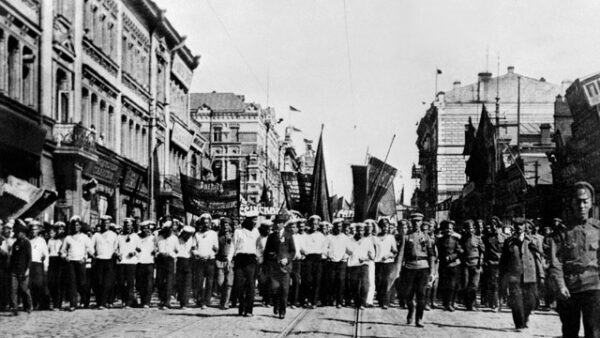
Capitalism’s ‘alternative facts’
By obscuring the real lessons of the Russian Revolution, right wing historians have an eye not only on the past but also on the future. The capitalist establishment rightly senses new revolutionary upheavals are on the way, and fears nothing more than that workers and youth should recreate a movement based on the genuine socialist ideas of the Russian Revolution and of Lenin and Trotsky. Today capitalism is in a terrible crisis worldwide as shown by the rise of Trumpism and the fact that eight super-rich plutocrats own as much wealth as the poorest half of humanity.
Pro-capitalist historians portray February as a ‘good’ revolution, which established democracy in Russia, but was subsequently undermined and overthrown by a ‘bad’ revolution in October. Richard Pipes, a former advisor to President Reagan, who has authored several books on the Russian Revolution, is typical of this school. In an interview last year, Pipes said he planned to celebrate the 100th anniversary of the February Revolution but “totally ignore” October.
On the same note the historian Orlando Figes says February was “the real revolution” while October was a “coup d’etat”. These ‘experts’ wish to disguise the fact that the working class made both revolutions, which in point of fact were different stages of the same revolution.
In order to demonise the Bolsheviks and the October Revolution, Figes exaggerates the democratic achievements of the February regime: “With breathtaking speed the Provisional Government passed a dazzling series of reforms in the spring of 1917. Russia overnight was effectively transformed into the ‘freest country in the world’ (Lenin). Freedoms of assembly, press and speech were granted. Legal restrictions of religion, class, race and gender were removed. Universal adult suffrage was introduced.” [www.orlandofiges.info]
Lenin did indeed say, “Russia is now the freest of all the belligerent countries” (Lenin’s April Thesis), although he was describing the outcome of the revolution not the policies of the bourgeois government. “Behind a screen of revolutionary phrases, this government is appointing partisans of the old regime to key positions,” he also warned.
The working class in Russia understood only too well that its newly won democratic rights had been achieved through struggle. These freedoms were taken rather than ‘granted’ by the government. It was the strength of the workers’ organisations and especially the soviets (workers’ councils) that prevented the Provisional Government in league with the remnants of the tsarist regime from rolling back these gains (something they would increasingly try to do, as shown by the right wing coup attempt of General Kornilov in August).
Capitalism and universal suffrage
The government’s order for the release of political prisoners for example merely rubber-stamped what had already occurred, with workers and soldiers themselves forcing open the prison cells. As for its promise of universal suffrage, this remained on paper. The government continuously postponed elections to the promised Constituent Assembly, using this as a filibuster tactic against mass demands for land reform and an end to the war. The Provisional Government itself was never elected but rather appointed by the Duma, which was elected on an extremely restricted franchise with only one in six of the adult population eligible to vote.
At that time very few capitalist countries practised universal suffrage, with New Zealand and Finland as notable exceptions – the latter as a direct result of the 1905 Russian Revolution. In major capitalist ‘democracies’ like the US and Britain, and the same for most of Europe, it was not until after the October Revolution in 1917, and the revolutionary shockwaves this detonated around the world, that capitalist regimes were forced to concede full voting rights. Women in France and Greece did not win the right to vote until after the Second World War and for Afro-Americans in the US it would take another two decades. Everywhere, democratic rights have been won through mass struggle and the Russian Revolution of 1917 played a crucial role in advancing this struggle globally.
In an interview last year, Pipes said he planned to celebrate the February Revolution but “totally ignore” October.
Capitalist hypocrisy
It was only after February, faced with revolution as a fact, that the capitalists internationally became converts to a ‘democratic Russia’. The British parliament mostly comprised of pro-tsarist Conservative and Liberal politicians hypocritically voted to send its “heartfelt congratulations” to the Russian people. Just one year earlier the British government had made Nicholas II an honorary Field Marshal in the British Army. Britain’s ‘free press’ had been particularly extravagant in its praise for the Russian dictator. The Times newspaper, owned by the warmongering press mogul Lord Northcliffe, had applauded the tsar’s “strong character” and “iron will”, claiming he “was loved by those under his command”. The view of the British capitalist class and government had always been that the tsar’s dictatorship was necessary to “hold Russia together”.
It was the workers’ movement in Britain and internationally that opposed tsarism, as was the case in 1909 when the tsar made a state visit to England. Reminiscent of today’s mood against a certain US president, thousands opposed the Russian monarch’s state visit by demonstrating in Trafalgar Square behind the banner “Down with Nicholas the Tyrant”.
Wrong footed by the February Revolution, capitalist governments feigned support for ‘democracy’ in Russia providing its capitalist economy and imperialist military alliances remained in force, and that the new regime honoured its forerunner’s massive debts to the Western banks.
Provisional Government
The Provisional Government was paralysed from the outset. Trapped within the framework of bankrupt Russian capitalism, it failed to solve any of the major problems weighing upon Russian society: the war, economic collapse, and most importantly the agrarian question (land to those who till it).
At the same time the working class through the experience of the February uprising and the preceding decade and a half of intense class struggle, achieved a degree of organisation and political consciousness never seen before. Crucial for the revolution was the reappearance on an even greater scale of the soviets, which were rooted in the experience of the unsuccessful 1905 revolution.
The Petrograd Soviet had 3,000 delegates elected from most factories and workplaces. Delegates received no economic privileges and were subject to immediate de-selection, making this the most democratic political system ever seen and the embryo of a workers’ government. Soviets sprang up across Russia, also drawing in the soldiers and the rural masses.
A state of ‘dual power’ existed between February and October, which in one form or another is manifested in all revolutions. As Guchkov, the new Minister of War confessed: “The government, alas, has no real power: the troops, the railroads, the post and telegraph are in the hands of the Soviet. The simple fact is that the Provisional Government exists only so long as the Soviet permits it.”
Instinctively, workers viewed the new government comprising some of Russia’s wealthiest businessmen and landowners with hostility. But they found themselves checked by their own leadership, especially the ‘moderate’ Mensheviks and Social Revolutionaries (SRs), who in February enjoyed a huge majority in the soviets.
With the sole exception of Alexander Kerensky, a lawyer allied with the SRs (a moderate rural-based ‘socialist’ party), who became Minister of Justice (and later Prime Minister), the new government contained no trace of the forces that had made the revolution. As the Bolshevik worker activist Kayurov exclaimed, “Has the workers’ blood been flowing in the streets of Petrograd for three days merely to exchange one landlord for another?”
A political “partition-wall”
In his ‘History’, Trotsky elaborates how this contradictory situation arose. The most militant layers of the working class, especially those influenced by the Bolsheviks, had played the key role in the February uprising. In a revolution, “activity prevails”: a conscious and resolute minority play the decisive role with the support of the broad masses. But after the fall of the old regime things begin to change with much bigger and previously passive layers flooding into the political arena. These layers are initially unable to distinguish between the different political parties and groups, all of whom – including the capitalist parties – have begun to pepper their speeches with ‘revolutionary’ language.
In this situation the most conscious workers find themselves in a minority at least for a period. The Bolsheviks in the immediate post-February period had only two percent of the votes in the soviets (their representation would increase sharply, winning a majority by September). The Mensheviks and SRs used their dominant position to vouch for the new capitalist government and generate illusions in it.
“The revolutionary tendencies of the masses, even at the moment of the February revolution, did not at all coincide with the Compromise tendencies of the petty bourgeois parties. The proletariat and the peasantry voted for the Mensheviks and the Social Revolutionaries not as compromisers, but as opponents of the czar, the capitalists and the landowners. But in voting for them they created a partition-wall between themselves and their own aims. They could not now move forward at all without bumping into this wall erected by themselves, and knocking it over.” [Trotsky, The History of the Russian Revolution]
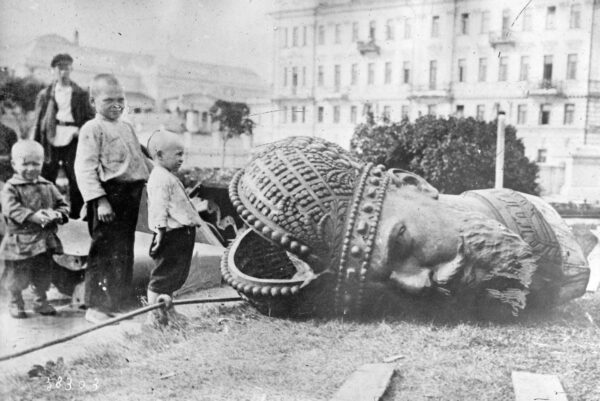
Stages theory
The Mensheviks and right wing SRs clung to the belief that this was a capitalist revolution – because Russia was a backward predominantly peasant economy. Therefore, they argued, it was necessary for the working class and its parties to support a capitalist government and suppress their own demands. This was one of the earliest manifestations of the so-called ‘stages theory’ – a hallmark of the Stalinist Communist Parties ever since. In China, Spain, Chile, Iran and elsewhere, marvellous revolutionary opportunities have been destroyed as a result of following the failed Menshevik ‘stages’ approach rather then the successful Bolshevik approach of 1917.
After the February Revolution there was confusion even within the ranks of the Bolshevik Party over the alleged ‘impossibility’ of the working class taking power in Russia. The first Bolshevik leaders to return to Petrograd from exile, including Stalin and Kamenev, shifted the party sharply to the right with a position of support for the Provisional Government, continuing a ‘defensive’ war, and for a merger with the Mensheviks.
Lenin, on his return to Russia in April 1917, would wage an internal political struggle to reorient the party, stressing the need for complete political independence on the part of the working class and an orientation to the most oppressed layers who were growing impatient with the ‘official’ compromise leaders of the soviets. This is something we will feature in later articles.
In our own time more and more workers and youth will grasp these crucial lessons and re-establish socialism as a powerful mass alternative to capitalism.

The Committee for a Worker’s International has launched 1917revolution.org to feature exclusive reports and analysis commemorating the Russian Revolution 100 years ago.

